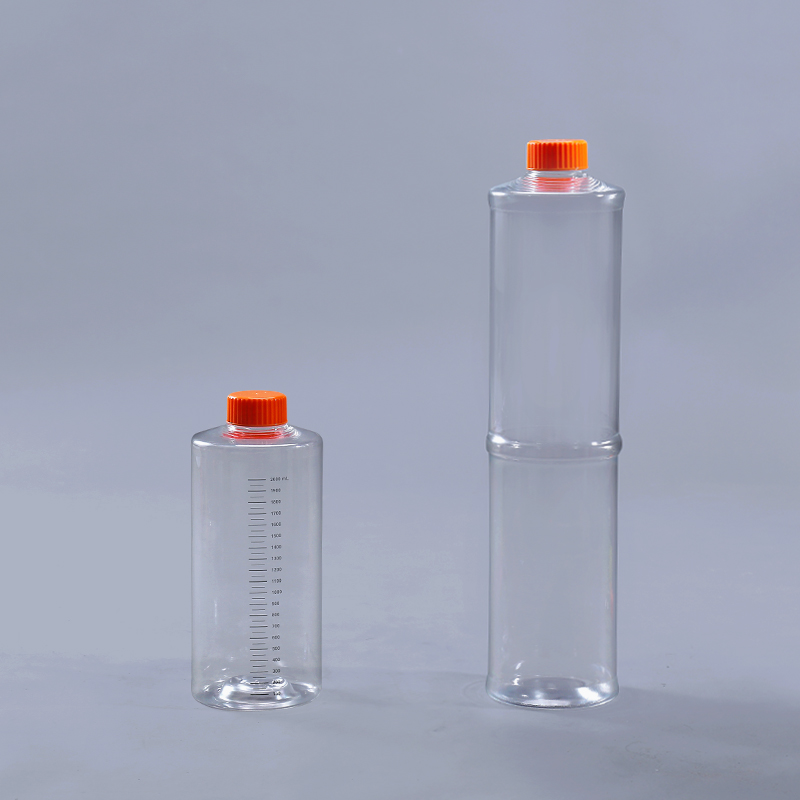, după cum sugerează și numele, este un tip de consumabil folosit pentru cultivarea celulelor. Cu ajutorul sistemului de sticle cu role de cultură celulară, este utilizat pe scară largă în domeniile biologiei celulare, virologiei, microbiologiei și industriei farmaceutice. conținut în domeniul științelor vieții. Există multe tipuri de celule cultivate, de la viruși la bacterii la ciuperci, de la celule umane la celule animale și celule vegetale. Unele celule și țesuturi pot crește în suspensie, dar un număr considerabil de celule de mamifere trebuie să fie atașat la suprafață, astfel încât cerințele pentru consumabilele de cultură celulară sunt relativ mari. de celule aderente și celule suspensie, cum ar fi celulele Vero, celulele HEK 293, celulele CAR-T, MRC5, celulele CEF, macrofagele alveolare porcine, celulele de mielom, celulele DF-1, celulele ST, celulele PK15, celulele Marc145 și alte celule aderente ; celule în suspensie, cum ar fi celulele CHO, celulele de insecte, celulele BHK21 și celulele MDCK.cell roller bottlesExistă diferite tipuri de consumabile pentru cultura celulară. Sticlele cu role celulare sunt doar una dintre ele. Baloanele de agitare de înaltă eficiență, fabricile de celule, plăcile de cultură celulară, vasele de cultură bacteriană etc. sunt toate consumabile celulare. Fiecare consumabil se bazează pe cerințele de utilizare și pe metodele de cultură celulară. Corespunzând diferitelor specificații și materiale, este un element esențial în procesul de cultură celulară.
In vitro culture of cells and tissues has become an indispensable content in the field of life sciences. There are many types of cultured cells, from viruses to bacteria to fungi, from human cells to animal cells and plant cells. Some cells and tissues can grow in suspension, but a considerable number of mammalian cells need to be attached to the surface, so the requirements for cell culture consumables are relatively high.
The cell roller bottles are suitable for the cultivation of a variety of adherent cells and suspension cells, such as Vero cells, HEK 293 cells, CAR-T cells, MRC5, CEF cells, porcine alveolar macrophages, myeloma cells, DF- 1 cells, ST cells, PK15 cells, Marc145 cells and other adherent cells; suspension cells such as CHO cells, insect cells, BHK21 cells and MDCK cells.
There are various types of consumables for cell culture. Cell roller bottles are just one of them. High-efficiency shake flasks, cell factories, cell culture plates, bacterial culture dishes, etc. are all cell consumables. Each consumable is based on usage requirements and cell culture methods. Corresponding to different specifications and materials, it is an essential item in the cell culture process.
The FAI climbed 5.9 percent year-on-year in the first 11 months of 2018, quickening from the 5.7-percent growth in Jan-Oct, the National Bureau of Statistics (NBS) said Friday in an online statement.
The key indicator of investment, dubbed a major growth driver, hit the bottom in August and has since started to rebound steadily.
In the face of emerging economic challenges home and abroad, China has stepped up efforts to stabilize investment, in particular rolling out measures to motivate private investors and channel funds into infrastructure.
Friday's data showed private investment, accounting for more than 60 percent of the total FAI, expanded by a brisk 8.7 percent.
NBS spokesperson Mao Shengyong said funds into weak economic links registered rapid increases as investment in environmental protection and agriculture jumped 42 percent and 12.5 percent respectively, much faster than the average.
In breakdown, investment in high-tech and equipment manufacturing remained vigorous with 16.1-percent and 11.6-percent increases respectively in the first 11 months. Infrastructure investment gained 3.7 percent, staying flat. Investment in property development rose 9.7 percent, also unchanged.
 English
English



















































